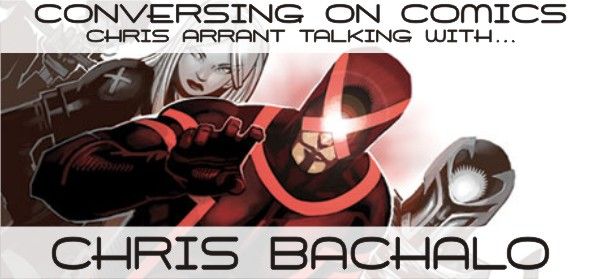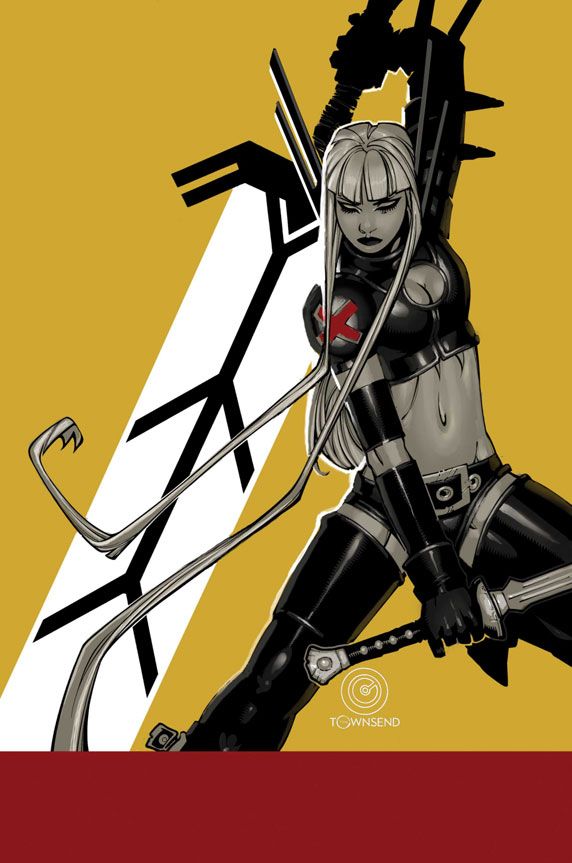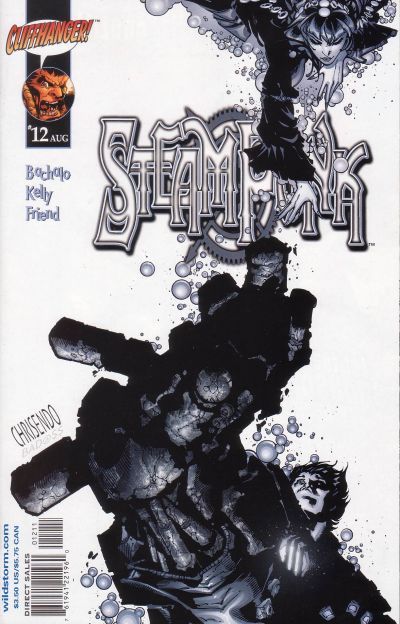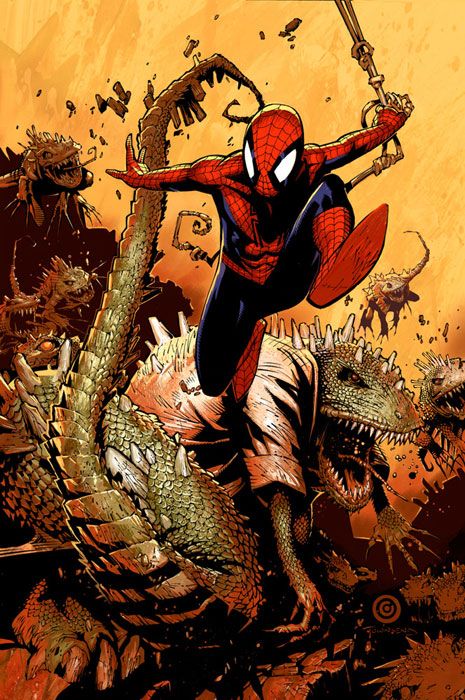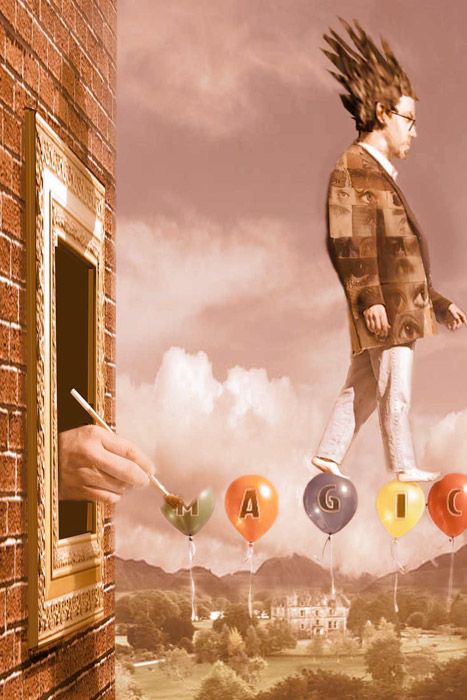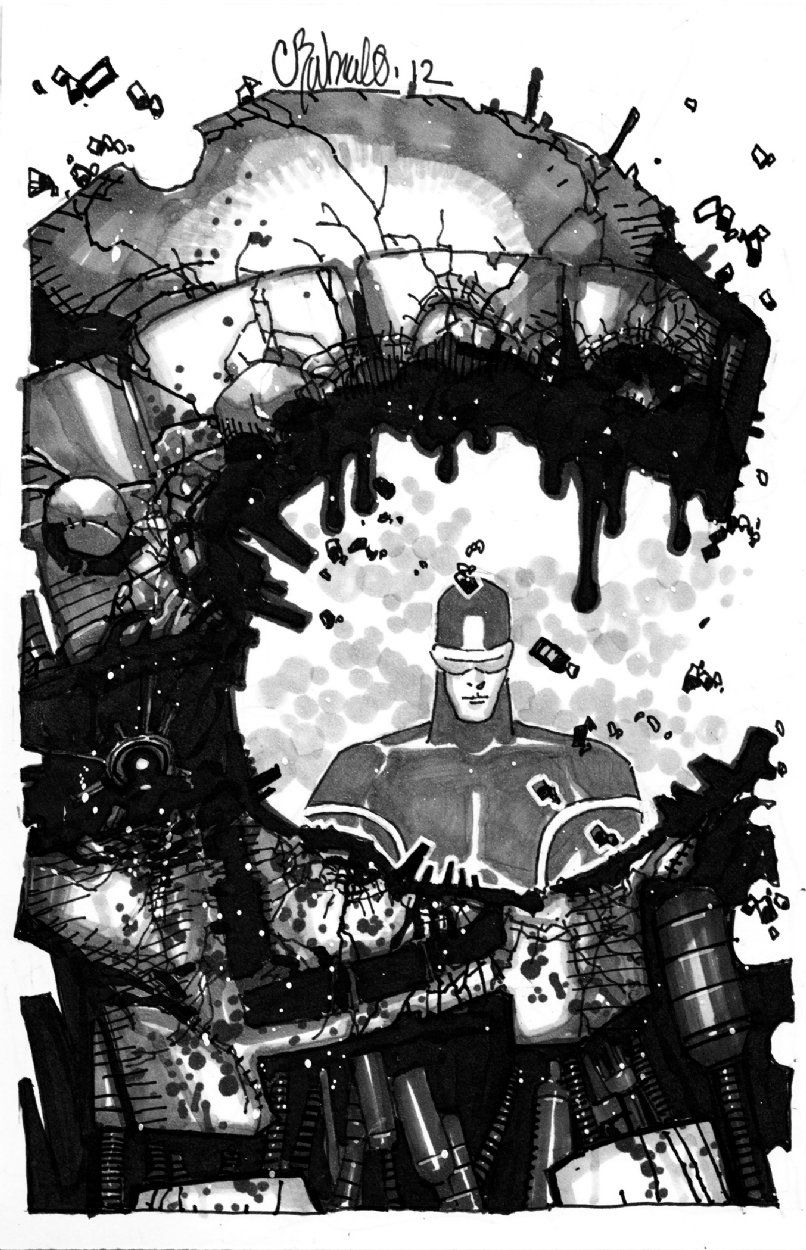Chris Bachalo is one of the preeminent superhero artists working in comics today, but that's not what he originally wanted to do. Despite quietly becoming the most prolific X-Men artist of all time, Bachalo got his start in a far different place: Vertigo. As a child and teenager, he actively avoided X-Men comics, and his passions lay instead with more experimental artists like Bill Sienkiewicz and Dave McKean. But now as a 23-year veteran of comics he's one of Marvel's top artists.
But that doesn't mean he isn't prone to experiment.
Hard at work on the eighth issue of Uncanny X-Men, is redefining the franchise's flagship title with writer Brian Michael Bendis while also planning a themed art book called Giant Robot Destroyer that collects drawings he's over the years. And yes, he's also thinking about Steampunk.
ROBOT 6: After so many stints doing various X-titles, what was unique about this new Uncanny X-Men book that made you want to jump on it?
Chris Bachalo: Bendis ...
[laughs] Easy enough. Speaking about your long tenure on the X-Men, how do you feel about being so synonymous with Marvel's mutants?
Not sure how to feel about that. It's kind of something that I fell into. I mean, I didn't have it on my list of goals. Had you have told me when I was in school that I would be associated with the group, I would have been surprised -- as I would have envisioned more of career at Vertigo drawing Swamp Thing. That was what I was into.
Speaking of Vertigo, you started off in a far different place with Shade, The Changing Man and Death: The High Cost of Living. Transitioning to being an X-Men artist is a big jump, so was it something you were a fan of and/or had ambitions to work on even back then during your Vertigo days?
Not at all. I'm a contrarian at heart. I grew up when the Claremont/Bryne Uncanny X-Men book was on top and made it point to stay as far away from that book as possible. I'd grab an issue or two here but it was never a fixture in my collecting life. I did start picking the book somewhat later when Jim Lee came on. I was amazed by his work!
I've read your favorite X-Man is Rogue, and you had the chance to write her in a short for A+X with Black Widow. How'd that come about, and do you have any ambitions to do more writing?
We had some time to kill, as Brian was gearing up to write Uncanny X-Men, and editor Nick Lowe asked about co-writing an A+X entry -- and that I could pick the line-up. Thought about who would be fun, and Widow and Rogue seemed like a nice fit and I asked to write solo. Wrote proposal and received a green light.
Speaking of writing and drawing, I have to ask about Steampunk. Do you and Joe Kelly have any plans of reigniting that, either by collecting the old issues or possibly doing more?
I wouldn't say that we had plans to bring the book back, but it is an item that remains on the table. I get asked about it weekly, every time of which catches me by surprise as the book has been pretty much out print for going on 10 years now.
Thing is, I have to be very cognizant of what I'm working on. Basically, it's one project at a time. I have a little time for a commission here and an email there, but taking on something big would be ambitious. Steampunk might be a situation in which I might draw covers and play an editorial role -- something like what Todd McFarlane does with Spawn or Mike Mignola with Hellboy. It's something I need to sit down and figure out.
Steampunk is a lot of fun, and Joe and I still have a lot to say. I was always a dissenter of creator owned properties that were launched and then quickly abandoned- and I appear to have become one of them with this project. Kind of embarrassed about the whole thing. Proud of what we did and it would be appropriate to finish the thought ...
I've noticed you have a special sense of pride and dedication to costume design in your work. In this new Uncanny X-Men series it was part of the gig, but in various superhero books I've seen you on I've noticed you putting your own spin on things. Is costume design something you wrestle with in your mind a lot?
I don't. It's not something I look forward to as it's the hardest part about launching a book. The first three to four issues of any launch, getting the vision of the book down on paper, familiarizing myself with the characters and who they are is a beast. After that it's a smoother road.
I was asked to redesign all of the characters for the Uncanny X-Men launch, and I just held my head for a few days at the prospect. One issue was that we were so early on in the process that there wasn't even an outline from which to pull ideas -- to get a sense of what the characters were about, what was happening with them. I like having details about the characters. It gives me something to hang onto and run with.
There are always new things that creep up during a run of issues but those are easier to get over one at a time than having to deal with all of them at once. I mean, every costume has been done to death, so at this point the best you can do is stir the pot and hope for a slightly different flavor.
I often think that it must be something that writers of music go through these days. Has every pop/rock and roll song been written? Are there sequences of musical notes that can be lined up to create something absolutely new -- that no one has ever heard before? I think the music business suffers more from this more than anything else -- that all the best songs have been written.
How many truly great costumes designs/characters have been created of late? Look at the top 100 comics in the industry. Most feature characters/ideas were established back in the '60s.
I do my best with the designs but it's a challenge to try and come up with the next great Spider-Man costume. I think the best I can hope for is to come up with something at least as good as the previous design.
I was asked to redesign the Lizard a little ways back and, honestly, I had no idea of what to do with it. I really liked the the version that I was working with and didn't think I could improve upon that. Called them up and shared that with them -- that I didn't know what to do. They asked to keep trying. That ended up being one instance in which I thought the new design was less that the original. That was tough emotionally, as I take pride in creating costumes that are good-looking, practical and clean, and I feel like I bombed on that one.
Speaking of costume design, still one of my favorites is your Generation X character Chamber. Next year's his 20th anniversary -- is he something that stands out to you much in history, or just one of many you did over the years? What are your thoughts on Jono?
My biggest apprehension about leaving a visually rich book like Shade, the Changing Man and entering the conservative superhero genre was that I wasn't going to have a lot fun, that there wasn't going to be interesting things to draw. Jono was Scott Lobdell's baby. I recall sitting with him at Comic-Con International back in summer of '93, I think, and he described the character and I knew everything was going to be okay. Chamber was crazy.
Getting into your storytelling style, I've been following you since Shade, The Changing Man, and noticed for the past few years -- since Amazing Spider-Man -- you've been developing your views and angles, especially in doing very close-up scenes where it sometimes feels as if the characters are breathing on you through the page. Is this something you've done intentionally, or just a natural progression for you?
It's very intentional. I do not want to stand still so I'm always trying to find new ways at exploiting the page. Sometimes it works out, others not so much. People let me know. they say, " I really liked the way you drew Death." "I like Generation X." "Steampunk was the best." "Steampunk was the worst!"
With Uncanny X-Men I've playing with the gutters, the negative space on the page. Opening up white plains that, I hope, frame and compliment the action in the panels and squeezing them closer together. It's an idea I stumbled across in Issue 8 of Wolverine & the X-men. There was a sequence when two pages opened up and I enjoyed how the negative white space complimented the live art.
I'd been working on that since the "Supernovas" arc of X-Men, when I started experimenting with knocking out the border lines, letting the the colors define the edge. It seemed to click for me on that Wolverine & The X-Men sequence. In the Amazing Spider-Man "Shed" storyline, I tried as much as possible to employ only vertical panels. McFarlane did a lot of that when he was on the book and I wanted to expand on the idea. It forced me to be creative with the layouts, created a nice energy. Something that worked well for Spidey. It's not something that would work with Uncanny X-Men. Too many characters running around.
In Avengers #15 I leaned the entire fight scene with the Hulk sideways to see what that would look like and really liked how it turned out. Thought that pages looked more dynamic. Carrying on with that idea as well in Uncanny X-Men.
In general, are you always looking for and thinking of new techniques to employ or trying new things?
Yes. Another example was about 10 years ago when I started coloring my own work. That created a whole new dynamic, as I started thinking more about color and the page as a finished product. It affected the way that I addressed drawing the book, especially the FX and backgrounds. I also know that if I screwed up the pencils I could makes adjustments in the coloring stage. I challenge myself to experiment with color, using it to contrast scene changes or define mood and emotion.
My biggest hero is Bill Sienkiewicz. The work that he created on books like Elektra and Daredevil: Love and War are beyond words -- I think the best examples of comic book art we'll ever see. I'd bring them into my university illustration classes when the instructors would disparage about comic art and they were very impressed. Those books are great inspirations for me. I'm still humbled by the work. Even more now that I was when i was younger.
One other thing I wanted to ask is about brief experiment with more "fine art" style cover work with Hunter: Age of Magic. I loved those covers, but haven't seen you approach that style before or since. What can you say about that time period and those pieces?
Yes, that 's another example of the subject matter defining the work. Dave McKean is a hero of mine. I liked the way he incorporated painted art with photography and I wanted to give that a try. It would be fun to try that again at some point, but only with an appropriate subject.
Are there things you want to try with your art that you haven't been able to yet ... or have, but haven't published?
Yes. I'd like to draw a book the way a I draw commissions -- loose and kind of sketchy. Not so clean. Maybe with the gray Copics and understated color. Or, no color at all. Something similar to the way I drew my Batman: Black & White entry. Very graphic. I'm looking for an excuse to do that.
I also have on my mind adjusting the way that I'm currently coloring. I haven' t found what that is yet -- but I've been coloring the way I am for a little while now and it feels like I need to adjust something. I have an itch. Looking around for ideas.
Don't be surprised if Uncanny X-Men looks a little different down the road. The tough part with the first four issues what that I had very little time to draw and color them and I was on auto-pilot. I should have more time going forward. Let’s see what happens.

